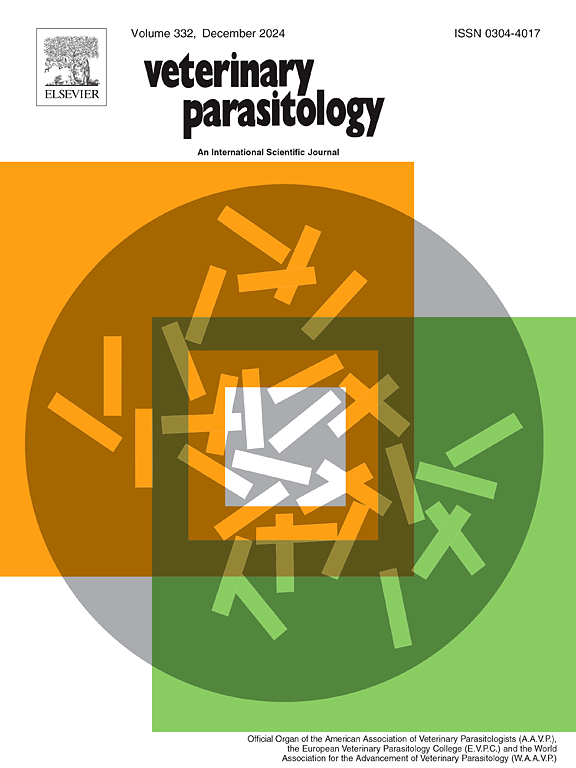Exploring cryopreservation alternatives for Dirofilaria immitis microfilariae
IF 2.2
2区 农林科学
Q2 PARASITOLOGY
引用次数: 0
Abstract
Canine Heartworm Disease, caused by Dirofilaria immitis, primarily affects canids and felids. The earliest studies on cryopreservation were carried out at −70°C, achieving acceptable survival rates, however microfilariae (mf) showed alterations both in morphology and motility. Thereafter, liquid nitrogen was used representing an excellent tool for long-term preservation, albeit it is expensive and requires trained personnel. Accordingly, the aim of this study was to develop a protocol for cryopreservation of D. immitis mf at −80°C feasible to laboratories with limited specialized equipment. The cryoprotectant medium was composed by 5 % dimethyl sulfoxide, 20 % of newborn calf serum and 75 % of saline solution. At Study Day (SD) 0 whole blood from a D. immitis naturally infected dog was diluted with the medium at a ratio of 1:1 and stored at −80°C using a freezing container (Nalgene® Mr. Frosty® Cryo 1°C). On the SD1 and then once a month, one cryovial was thawed and examined for survival, motility, length and morphology of mf. On SD 1, the mf showed a survival rate of 99 %. By SD 120 the survival rate gradually decreased (up to 63 %) and a shift in motility patterns between the “medium” and “slow” classes, was observed. On SD 150, the survival rate exceeded 50 % and mf did not exhibit detectable morphological alterations; however, a reduction in length was observed. This study marks the first protocol where the −80°C freezer has been employed for cryopreservation of D. immitis, integrating the application of cryoprotectants and novel techniques for gradual temperature transition.
探索冷冻保存软下疳微丝蚴的替代方法。
犬心丝虫病是由密螺旋体二螺旋体(Dirofilaria immitis)引起的,主要影响犬科动物和猫科动物。最早的冷冻保存研究是在零下 70 摄氏度条件下进行的,取得了可接受的存活率,但微丝蚴(mf)的形态和运动能力都发生了改变。此后,液氮被用来作为长期保存的绝佳工具,尽管价格昂贵,而且需要训练有素的人员。因此,本研究的目的是开发一种在-80°C条件下冷冻保存白僵菌 mf 的方案,这种方案对于专业设备有限的实验室来说是可行的。冷冻保护培养基由5%的二甲基亚砜、20%的新生小牛血清和75%的生理盐水组成。在研究日(SD)0,将自然感染的狗的全血与培养基按 1:1 的比例稀释,并用冷冻容器(Nalgene® Mr. Frosty® Cryo 1°C)保存在 -80°C 的温度下。在 SD1 期和以后每月解冻一次冷冻样品,检查 mf 的存活率、运动性、长度和形态。在 SD1,mf 的存活率为 99%。到 SD 120 时,存活率逐渐下降(降至 63%),并观察到运动模式在 "中等 "和 "慢速 "两级之间发生变化。SD 150时,存活率超过50%,mf未出现可检测到的形态变化,但长度有所减少。这项研究标志着首次将-80°C冷冻箱用于水蚤的低温保存,并整合了低温保护剂的应用和新的温度渐变技术。
本文章由计算机程序翻译,如有差异,请以英文原文为准。
求助全文
约1分钟内获得全文
求助全文
来源期刊

Veterinary parasitology
农林科学-寄生虫学
CiteScore
5.30
自引率
7.70%
发文量
126
审稿时长
36 days
期刊介绍:
The journal Veterinary Parasitology has an open access mirror journal,Veterinary Parasitology: X, sharing the same aims and scope, editorial team, submission system and rigorous peer review.
This journal is concerned with those aspects of helminthology, protozoology and entomology which are of interest to animal health investigators, veterinary practitioners and others with a special interest in parasitology. Papers of the highest quality dealing with all aspects of disease prevention, pathology, treatment, epidemiology, and control of parasites in all domesticated animals, fall within the scope of the journal. Papers of geographically limited (local) interest which are not of interest to an international audience will not be accepted. Authors who submit papers based on local data will need to indicate why their paper is relevant to a broader readership.
Parasitological studies on laboratory animals fall within the scope of the journal only if they provide a reasonably close model of a disease of domestic animals. Additionally the journal will consider papers relating to wildlife species where they may act as disease reservoirs to domestic animals, or as a zoonotic reservoir. Case studies considered to be unique or of specific interest to the journal, will also be considered on occasions at the Editors'' discretion. Papers dealing exclusively with the taxonomy of parasites do not fall within the scope of the journal.
 求助内容:
求助内容: 应助结果提醒方式:
应助结果提醒方式:


